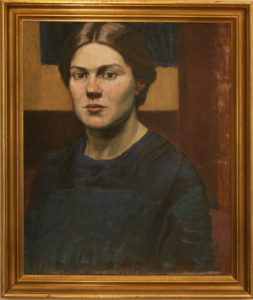
My grandmother Gwen Raverat, née Gwendolen Mary Darwin, was born on August 26th, 1895, just three and a half years after the death of her grandfather, evolutionary biologist Charles Darwin. Her work as an artist featured regularly in Time and Tide from the late 1920s and into the next decade, and in 1929 she became the magazine’s regular art critic.
Gwen grew up in the house next to the River Cam in Cambridge that her father Sir George Howard Darwin had named Newnham Grange. George was Charles Darwin’s fifth child; married to the American, Maud du Puy. Gwen and her sister Margaret had two brothers Billy and Charles. Margaret married Geoffrey Keynes, Blake aficionado, surgeon and brother of the world-famous economist Maynard. Charles would become a physicist, managing the British end of the Manhattan Project that developed the nuclear bomb.
Gwen’s early life was a confluence of several important torrents of change: the emancipation of women, particularly in the intellectual life of turn-of-the-century Cambridge, and the transformation of the arts, notably through the efforts of the Neo-Pagans – the soubriquet given by the writer Virginia Woolf to the coterie surrounding Gwen’s friend the poet Rupert Brooke. (Woolf wrote of this group that they were “exuberant, untrammelled, delighting in physical existence and in nature”.) Gwen was the epitome of a no-nonsense artist, her approach informed by a Darwinian perseverance with detail and a Neo-Pagan romanticism. It is no coincidence that composer Ralph Vaughan Williams was Gwen’s second cousin – his grandfather, Josiah Wedgwood III was married to Charles Darwin’s sister Caroline. From inside the portals of the British upper middle classes they produced art of a transcendent, rebellious and elegiac quality.
Gwen’s Darwinian creative meme – pursuit of the beauty of what was in front of her – was strong enough that she dared to become a serious woman artist, studying at the Slade from 1908 to 1910 with Stanley Spencer, Mark Gertler, Dora Carrington and David Bomberg. It was through Spencer that Gwen was to meet her husband-to-be Jacques Raverat, and the poet Rupert Brooke. Her Darwinian persistence paid off: Gwen became an accomplished wood engraver with an international reputation. Rupert Brooke summed her up as the “square-headed woman who cuts wood”.
In an age when women could not vote, had only just been admitted to the university and were generally expected to prepare themselves for a life of familial and domestic routine, Gwen behaved with the independent-mindedness for which the Darwins were celebrated. So serious was her rebellion in insisting on doing serious, full-time art at the Slade that Gwen did not talk to her parents for two years while there.
Gwen married the French mathematician and artist Jacques Raverat later in 1911. He was diagnosed with what we now call MS in 1914 when trying to enlist in the French army. They moved in 1920 to Vence, near Nice in the South of France, for his health. He died in 1925.
Gwen had once confessed that she felt “so lonely and strange… I don’t know about people – they don’t know about me”. Now a widow and back in London, she was truly alone in the world, with the added responsibility of two young children. Once again, her awkward, disconcerting courage came to her rescue and, defying Virginia Woolf’s brilliant characterisation of her as “frozen, like an old log dried out of all sensation”, she poured her instinctive and formidable powers of observation into her work as an engraver, becoming one of the foremost miniaturists of her generation.
In 1927 Virginia Woolf introduced Gwen to Lady Rhondda. Gwen came to be regarded as Time and Tide’s resident artist and in 1929 she began writing art criticism and book reviews for the journal. Her approach to art is exemplified by this from Time and Tide in 1934: “Painting is the product of the thing seen (whether with the inner eye or the outer eye makes no matter) and the passion felt about it. Representational art is on the whole greater than abstract art, partly because it is difficult to have so primitive and passionate a feeling about a cube as about a cow; but also because the eye turned outwards constantly replenishes and enlarges the symbolic imagery of the mind; while the abstractist, his eye turned inwards, allows his images to grow poorer and fewer by inbreeding.”
Gwen’s Time and Tide contributions included pen-and-ink drawings and woodcuts for the magazine’s ‘Monthly Calendar’ feature, written by Eleanor Farjeon under the pen-name Chimaera, which appeared from May 1927 to December 1930. These contributions are significant in relation to Time and Tide’s increased use of illustration in the late 1920s, which distinguished the journal as the most visually arresting of the intellectual weeklies. From 1929 onwards, Gwen also contributed regular art criticism to Time and Tide, indicative of the journal’s growing interest in the visual arts besides literature.
Gwen moved back to Cambridge in 1938, producing copious wood-engraving book illustrations. She moved into the Old Granary, adjoining Newnham Grange, all now part of Darwin College, and there wrote her best-selling memoir Period Piece (still in print nearly 70 years later).
In 1951 Gwen suffered a stroke and became confined to a wheelchair. Unsentimental to the last, in 1957 she terminated her own life, writing: “This seems the simplest plan for everyone.” However, before she died, she had the satisfaction of knowing that her “strangeness” had found an audience.
By William Pryor. William is Gwen Raverat’s grandson and Director of the Gwen Raverat Archive.
Sources include:
Clay, Catherine. Time and Tide: The Feminist and Cultural Politics of a Modern Magazine. Edinburgh: Edinburgh University Press, Ltd, 2019 (2018)